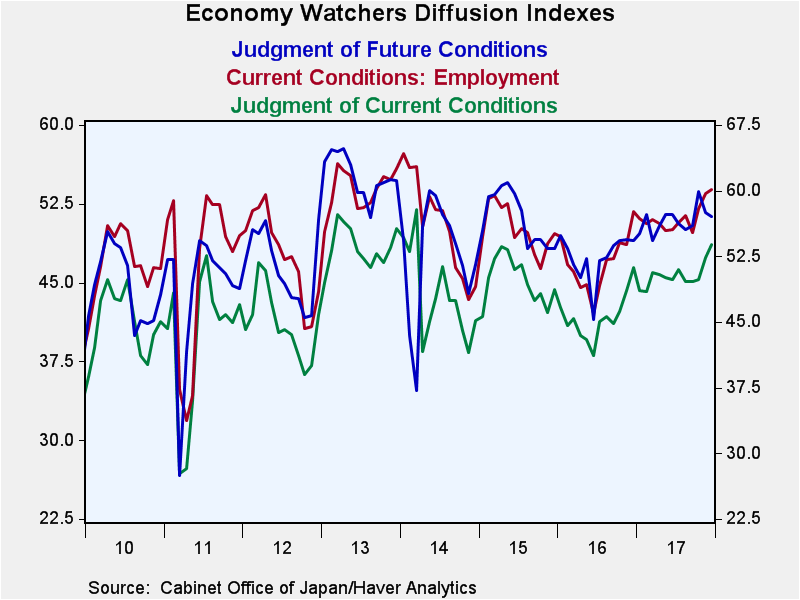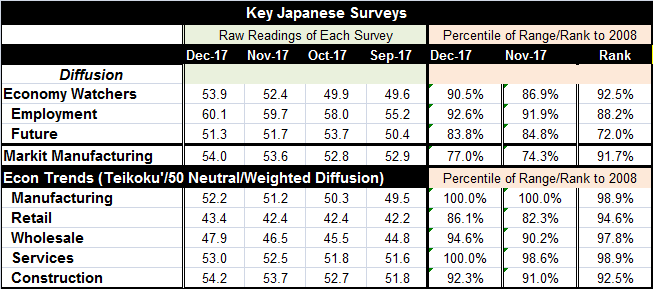 Global| Jan 12 2018
Global| Jan 12 2018Japan's Economy Watchers Index Gains As Future Index Deflates
Summary
The economy watchers index in Japan rose higher in December as current employment conditions improved. But expectations for the future slipped back. This novel Japanese index is a survey of people in the service sector who observe (or [...]
 The economy watchers index in Japan rose higher in December as current employment conditions improved. But expectations for the future slipped back.
The economy watchers index in Japan rose higher in December as current employment conditions improved. But expectations for the future slipped back.
This novel Japanese index is a survey of people in the service sector who observe (or watch) the service sector economy and provide assessments monthly of what they observe. In December, the 'economy watchers' saw a further advance in conditions, improved employment, but also began to have reservations about the outlook.
The economy watchers index sands at the 92.5 percentile ranking among all its values since 2008. That is to say that it has been this high or higher only 7.5% of the time. The employment situation is a little less strong, having been this strong or stronger only about 12% of the time. The future index is more moderate as it has been at its December level or higher about 28% of the time.
Note that the Markit manufacturing index is similarly evaluated and that index rose on the month to a 91.7 percentile standing, marking it as a similar reading in terms of relative strength to the service sector. The manufacturing PMI can only be evaluated back to January 2012.
The Teikoku survey of economic trends assesses manufacturing and a host of service subsectors plus construction. The Teikoku framework has manufacturing as well as each of the services subsectors as strong or stronger than the Markit index for manufacturing and the Economy Watchers index for overall services.
Notwithstanding the step down in the Economy Watchers Future index, these are extremely encouraging indexes about the health of the Japanese economy in December. They are also very up-to-date assessments.
Teikoku breaks the overall service sector into three components called Retail, Wholesale, and Services (other services). The services reading is highest reading on the timeline back to 2008. The manufacturing reading from Teikoku also is the highest back to 2008. The wholesale sector logs its second highest reading of that span and has been higher by only 5.4%. Retailing logs its fifth highest reading and it has been higher by 13.9%. All of these are extremely solid and strong readings. In addition, the construction sector has a 92.5 percentile standing in the Teikoku framework.
Globally, economies are doing better and central banks have begun to take steps or to plan to take steps to reverse their course of stimulus. The U.S. is the farthest along this process having begun to hike rates in December 2015. The Bank of England has more recently begun to reverse its course of stimulus by starting a cautious process of rate hikes. The ECB just yesterday released information implying that it might be ready to start reversing its asset purchase stimulus later this year. The Bank of Japan is the last stalwart sticking to a program of dedicated stimulus. And while the economic signals in Japan are looking much more solid, inflation in Japan continues to run at a pace below 1% and the BOJ is dedicated to a 2% target. Despite the better growth numbers, the BOJ seems destined to stay the course of stimulus longer.

Robert Brusca
AuthorMore in Author Profile »Robert A. Brusca is Chief Economist of Fact and Opinion Economics, a consulting firm he founded in Manhattan. He has been an economist on Wall Street for over 25 years. He has visited central banking and large institutional clients in over 30 countries in his career as an economist. Mr. Brusca was a Divisional Research Chief at the Federal Reserve Bank of NY (Chief of the International Financial markets Division), a Fed Watcher at Irving Trust and Chief Economist at Nikko Securities International. He is widely quoted and appears in various media. Mr. Brusca holds an MA and Ph.D. in economics from Michigan State University and a BA in Economics from the University of Michigan. His research pursues his strong interests in non aligned policy economics as well as international economics. FAO Economics’ research targets investors to assist them in making better investment decisions in stocks, bonds and in a variety of international assets. The company does not manage money and has no conflicts in giving economic advice.






